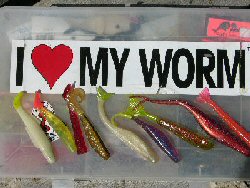Using Baits and Lures to Your Advantage
This is Passport to Texas
Nothing beats live bait for catching fish. Yet, manmade lures have been around a long time—because they work.
For example, take the spinner bait. The spinning blades are designed to catch a fish’s attention as they move through the water. The flashing silver looks just like a tasty minnow.
Steve Campbell worked in Outreach and Education at Texas Parks and Wildlife, specializing in angler education.
Another popular lure is the top water lure. Because it floats on top of the water, it works best in calm waters where it is visible to fish below. To use a top water…cast…wait for the bait to settle, and then pop your rod tip; repeat until you get a strike.
The crankbait is a fun lure to work with. It has a kind lip that extends from the front of the lure.
This lip causes the bait to dive down through the water as you crank on the reel. As soon as you cast your crankbait, turn the reel quickly a couple of times so the lip will catch the water and pull down. Stop reeling, and the lure begins to float back up. Your goal is to imitate an injured fish darting through the water.
Lures come in all shapes and sizes, and your tackle dealer can help you select the right lures for your next fishing trip.
And remember: while natural bait is best, it’s always a good idea to keep a couple of lures on hand when you get tired of feeding—I mean catching—the fish.
The Sport Fish restoration program supports our series.
For Texas Parks and Wildlife…I’m Cecilia Nasti.



 Passport to Texas is a
Passport to Texas is a  Passport to Texas is made available by:
Passport to Texas is made available by: